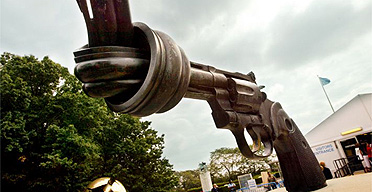





Monuments Related
to Pax Christi




| Monuments Related |
Click here for other churches. | Click here for monuments related to conscientious objection.
In 1945, a small group of people in France met regularly to pray for peace. Their concern was not a vague one. What bothered them, what kept them coming together was their experience of an agonizing and dreadful fact: French Catholics and German Catholics, who professed the same faith and celebrated the same Eucharist, had killed one another by the millions in the 20th century. That situation could hardly be the will of God, as they understood it. So they prayed for forgiveness, for reconciliation, for the peace of Christ.
A French woman, Marie-Marthe Dortel Claudot, is known as the leader and founder of the movement. She invited a French bishop, Pierre-Marie Theas [1894-1977], to be the first Bishop President. While in a German war prison camp in Compiegne, Bishop Theas had already begun to pray and work for reconciliation.
Soon after the war, Pax Christi centers were established in France and Germany; by the early 1950's the movement had spread to Italy, Spain, the Netherlands, Austria, Switzerland and Belgium.
Pax Christi began in the United States in 1972, thanks to the initiative of a tiny handful of U.S. Catholics, mostly lay. [Bishop Thomas Gumbleton of Detroit was the founding president.] There was no national office or full time staff person until 1979, and then the entire office was set up in two spare rooms of a Chicago convent. The national office moved to Erie, Pennsylvania in 1985 and remains there today.
Pax Christi is active in more than 30 countries, with a growing presence in Latin America and Africa. Our national office is located in Erie, Pa., and an international office and staff are located in Brussels, Belgium. Pax Christi has consultative status as a non-governmental organization at the United Nations.
Wherever they live throughout the world, members of Pax Christi are united by their purpose, which is expressed in the international statutes: "to work for peace for all humankind, always witnessing to the peace of Christ." They do this through prayer, study and action.
In 1982, speaking at Coventry Cathedral in England, Pope John Paul II said, "Like a cathedral, peace must be constructed patiently and with unshakable faith." Membership in Pax Christi enables many Catholics and other Christians of all walks of life to help build the cathedral of peace. [Foregoing information is from website of Pax Christi USA.]
Right click image to enlarge.



| H U R C H | T O N E S |



| U SE U M |
Comments: Using the slogan "Mehr als ein museum" / "More than a museum," the Friedens-Raeume (literally "peace spaces") occupy about four rooms on the left side of the ground floor of a lakeside villa apparently owned by the City of Lindau. (The psychiatrist who occupies another part of the villa displays his card at its main door.) If there were ever a "museum" without artefacts, this would be it. Displays are made up almost entirely from words, photos, art and furniture. All signs (and presumably all recordings) in the Friedens-Raeume are in German (obviously limiting the comprehention of all non-German speakers).The young lady who sold me a ticket and gave me a poor English translation of the "museum" brochure was very proud to demonstrate two filing cabinets near the entrance. Each cabinet had multiple drawers containing information typed (in German only) on non-removable laminated cards.
One cabinet had a drawer for each of 14 peacemakers -- Petra Kelly [1947-1992], Nelson Mandela [b.1918], Dorothee Sölle [1929-2003], Gonsar Rinpotsche [b.1949], Paulo Suess [b.1938], Hildegard Goss-Mayr [b.1930], Sophie Scholl [1921-1943], Hans Scholl [1918-1954], Sumaya Farhat-Naser [b.1948], Smail Balic [1920-2002], Astrid Lindgren [1907-2002], Konrad Link [unidentified by me], Anna Starke [1905-1993] & a mirror for sie / you!
The other cabinet had 16 drawers for various peace topics, none of which I could read except for one drawer listing other peace museums in Germany, Japan, the USA, and few other countries. This "directory" was years out of date, listing, for example, defunct peace museums in Chicago, Detroit, and Lincoln, Nebraska, and failing to name the Dayton International Peace Museum in Dayton, Ohio.
The only part of the Friedens-Raeume which appealed to me was an exhibit of the 1,000 women nominated for the Nobel Peace Prize in 2005. This was in part because a copy of "1000 PeaceWomen Across the Globe" (2005) in English was lying nearby. The index of this book contains a long list of 96 "keywords" which provide the most comprehensive modern definition of "peace" that I have ever seen (e.g. as categories of "museums for peace"). Click here to see the list of 96 "keywords." Click here to see the on-line version of the book, with 1,000 biographies arranged using the list of "keywords."


| R AI L | B E L I S K |
Comment: There are no words of any kind on the obelisk, and the small plaque does not explain why the aerial bombing of Coventry (England) is memorialized on the shore of Lake Constance. The missing link was provided by searching on-line for the meaning of "Nagelkreuzgemeinschaft" -- one of 18 peacemakers celebrated at the former peace museum in Bad Hindelang (see below).According to a Google translation, "Nagelkreuzgemeinschaft" means "Cross of Nails Community" in English. The translation goes on to say: " The Coventry Cross of Nails is a Christian symbol from the Coventry Cathedral. It is the idea of völkerweiten / reconciliation after the Second World War. The story of the Cross of Nails idea began on 14 November 1940 with the German bombing of Coventry in England, in which 550 people died and many buildings were destroyed, including St. Michael's Cathedral. In cleaning up the debris mediaeval church, the then provost, Richard Howard three large carpenter nails in the roof, the debris were rescued out of the, composed of a cross. He also had the words "FATHER FORGIVE" write to the choir wall and assemble a large cross made of two charred beams. While the wooden cross of the ruins of the old cathedral was in, nail the original cross is now on the altar of the newly built cathedral next door in 1962 and is considered a sign of reconciliation and peace. Worldwide, have ecumenical religious groups formed as a Cross of Nails Community. You are in Germany from 52 communities in 36 cities at present, worldwide there are currently over 160. The nail cross is awarded in recognition of the Community to parishes. As an outward symbol of this bond is passed to each of the communities nail cross a cross of three nails from Coventry, which is modeled on the original cross."


| L A Q U E |

| L A Q U E |

| T O N E |

| H U R C H | 
| H U R C H | E L L |
 

| U SE U M |
Comment: Thomas Wechs Jr. created the peace museum in Lindau, directed it until about 2000, then created the peace museum in Bad Oberdorf, and operated it until 2009. He is the son of famed architect Thomas Wechs [1893-1970] who built churches in both places. Note the museum website is still on-line but gives its "Contact" as Friedenshistorisches Archive, Burgkmairstraße 14, Augsburg 86152 (Germany), e-mail info * friedensmuseum.de.The website features (and presumably the museum featured) these 18 individuals and pairs: Cain & Abel, François Fénelon [1651-1715], Bertha von Suttner [1843-1914], Truus Wijsmuller-Meijer [1896-1978], Bishop George Bell [1883-1958], Martin Luther King, Jr. [1929-1968], Saint Marcellus the Centurion [c. mid 3rd century-298 AD], Archbishop Denis Auguste Affre [1793-1848], Popes Pius X & Benedikt XV, Franz Reinisch [1903-1942], Elisabeth von Fuchs Kemény [dates?], Reinhold Schneider [1900-1958], Francisco de Vitoria [c1483-1546], Florence Nightingale [1820-1910], Mahatma Gandhi [1869-1948], Nagelkreuzgemeinschaft / Cross of Nails Community (see below), Bishop Pierre-Marie Théas [1895-1977], and Werner Heisenberg [1901-1976].


|


| U R A L |

| 
|